heating OLDSMOBILE SILHOUETTE 1996 Owners Manual
[x] Cancel search | Manufacturer: OLDSMOBILE, Model Year: 1996, Model line: SILHOUETTE, Model: OLDSMOBILE SILHOUETTE 1996Pages: 372, PDF Size: 19.39 MB
Page 84 of 372
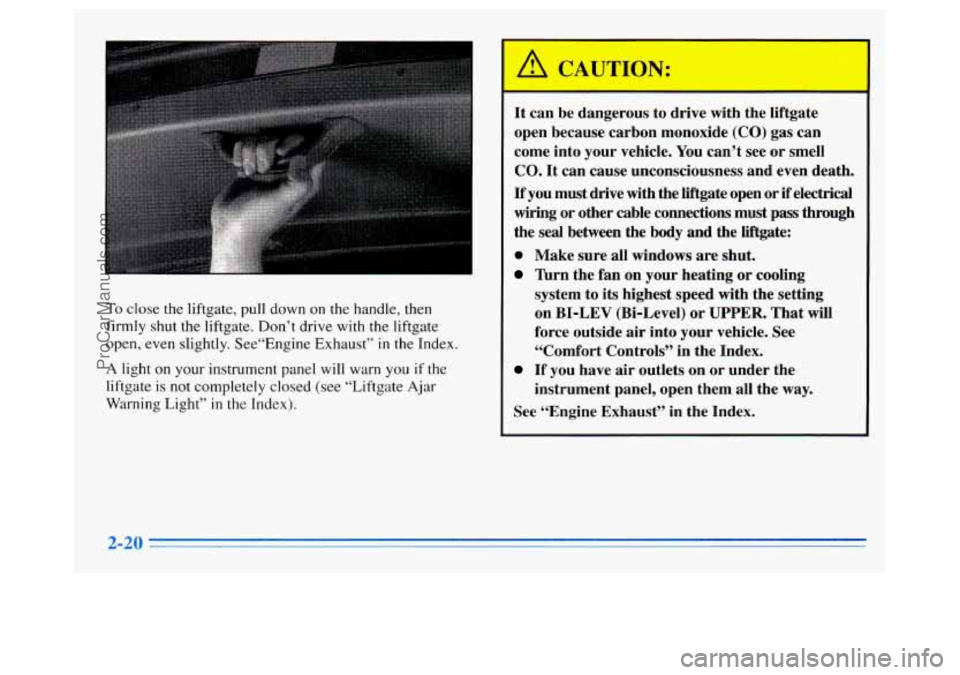
To close the liftgate, pull down on the handle, then
firmly shut the liftgate. DonŌĆÖt drive with the liftgate
open, even slightly. SeeŌĆ£Engine ExhaustŌĆØ
in the Index.
A light on your instrument panel will warn you if the
liftgate is not completely closed (see ŌĆ£Liftgate Ajar
Warning LightŌĆØ
in the Index).
2-
It can be dangerous to drive with the liftgate
open because carbon monoxide
(CO) gas can
come into your vehicle. You canŌĆÖt see or smell
CO. It can cause unconsciousness and even death.
If you must drive with the liftgate open or if electrical
wiring or other cable connections must
pass through
the seal between the body and the liftgate:
0 Make sure all windows are shut.
lhrn the fan on your heating or cooling
system to
its highest speed with the setting
on BI-LEV (Bi-Level) or
UPPER. That will
force outside air into your vehicle. See
ŌĆ£Comfort ControlsŌĆØ in the Index.
If you have air outlets on or under the
instrument panel, open them all the way.
See ŌĆ£Engine ExhaustŌĆØ in the Index.
ProCarManuals.com
Page 122 of 372
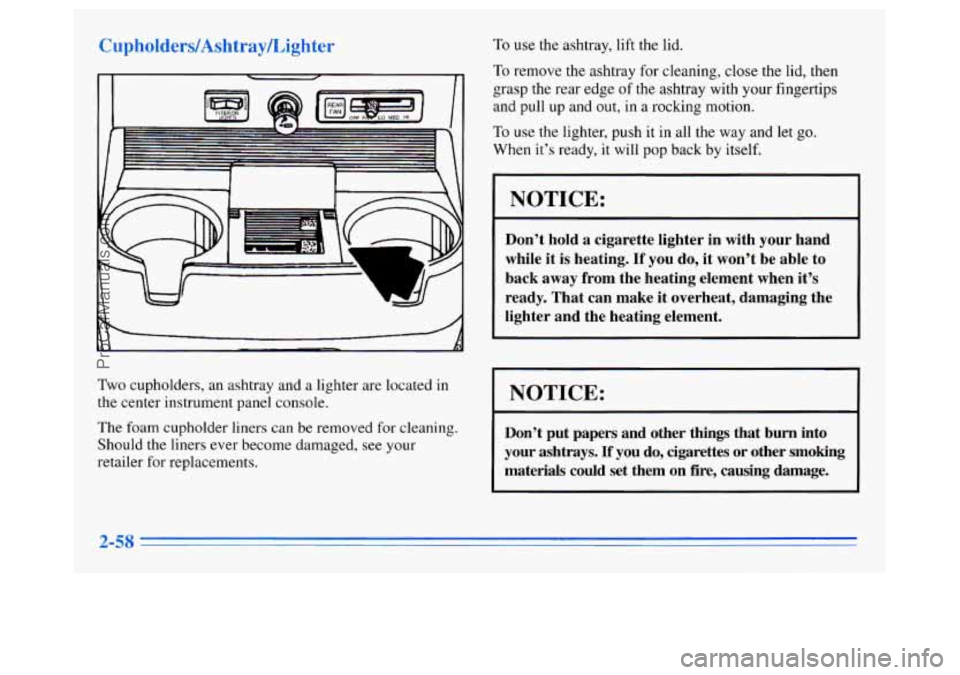
A
L
1:
Two cupholders, an ashtray and a lighter are located in
the center instrument panel console.
The foam cupholder liners can be removed
for cleaning.
Should the liners ever become damaged, see your
retailer
for replacements. To
use the ashtray, lift the lid.
To remove the ashtray
for cleaning, close the lid, then
grasp the rear edge of the ashtray with your fingertips
and pull up and
out, in a rocking motion.
To use the lighter, push it in all the way and let go.
When itŌĆÖs ready, it will pop back by itself.
NOTICE:
DonŌĆÖt hold a cigarette lighter in with your hand
while it
is heating. If you do, it wonŌĆÖt be able to
back away from the heating element when itŌĆÖs
ready. That can make it overheat, damaging the
lighter and the heating element.
I NOTICE:
DonŌĆÖt put papers and other things that burn into
your ashtrays.
If you do, cigarettes or other smoking
materials could set them on fire, causing damage.
ProCarManuals.com
Page 140 of 372
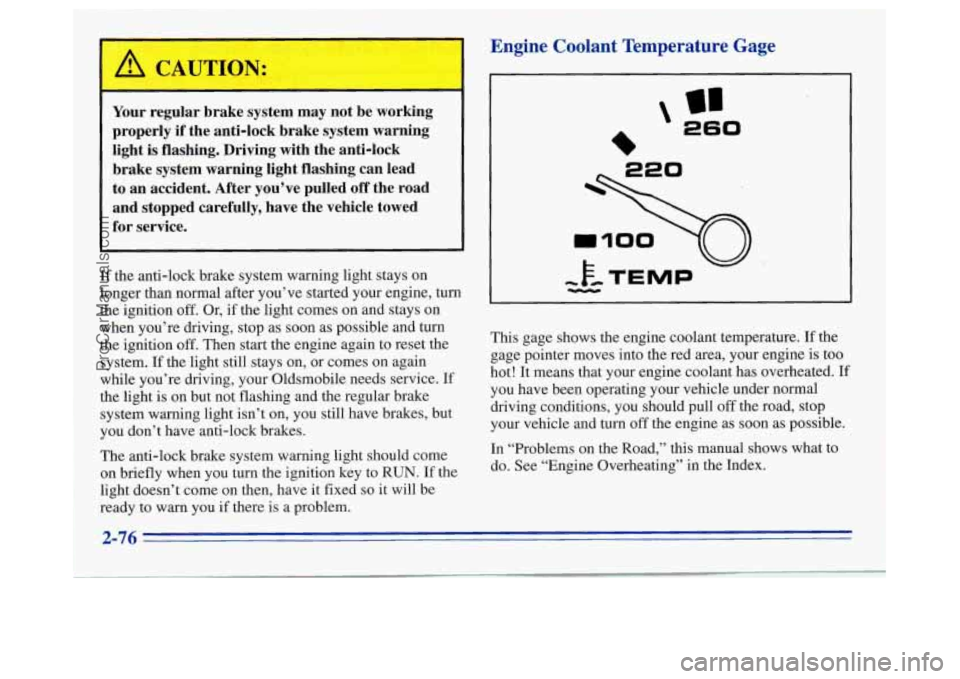
A CAUTION:
Your regular brake system may not be working
properly if the anti-lock brake system warning light
is flashing. Driving with the anti-lock
brake system warning light flashing can lead to an accident. After youŌĆÖve pulled
off the road
and stopped carefully, have the vehicle towed
for service.
If the anti-lock brake system warning light stays on
longer than normal after youŌĆÖve started your engine, turn
the ignition off. Or, if the light comes on and stays on
when youŌĆÖre driving, stop as soon as possible and turn
the ignition
off. Then start the engine again to reset the
system. If the light still stays on, or comes on again
while youŌĆÖre driving, your Oldsmobile needs service. If
the light is on but not flashing and the regular brake
system warning light isnŌĆÖt on, you still have brakes, but
you donŌĆÖt have anti-lock brakes.
The anti-lock brake system warning light should come
on briefly when you turn the ignition key to
RUN. If the
light doesnŌĆÖt come on then, have it fixed
so it will be
ready to warn you if there
is a problem.
Engine Coolant Temperature Gage
ŌĆÖ 260
This gage shows the engine coolant temperature. If the
gage pointer moves into the red area, your engine
is too
hot! It means that your engine coolant has overheated. If
you have been operating your vehicle under normal
driving conditions, you should pull
off the road, stop
your vehicle and turn
off the engine as soon as possible.
In ŌĆ£Problems on the Road,ŌĆØ this manual shows what to
do. See ŌĆ£Engine OverheatingŌĆØ in the Index.
ProCarManuals.com
Page 149 of 372
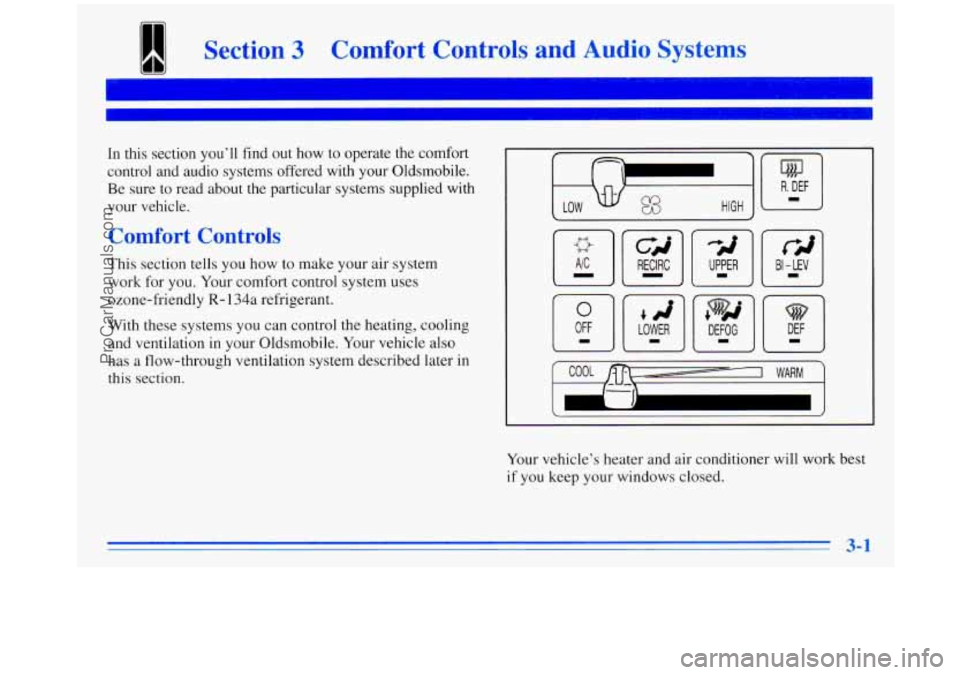
Section 3 Comfort Controls and Audio Systems
In this section youŌĆÖll find out how to operate the comfort
control and audio systems offered with your Oldsmobile.
Be sure
to read about the particular systems supplied with
your vehicle.
Comfort Controls
This section tells you how to make your air system
work for you. Your comfort control system uses
ozone-friendly
R- 134a refrigerant.
With these systems you can control the heating, cooling
and ventilation in your Oldsmobile. Your vehicle also
has a flow-through ventilation system described later in
this section.
rii
BI - LEV I
Your vehicleŌĆÖs heater and air conditioner will work best
if you keep your windows closed.
3-1
ProCarManuals.com
Page 152 of 372
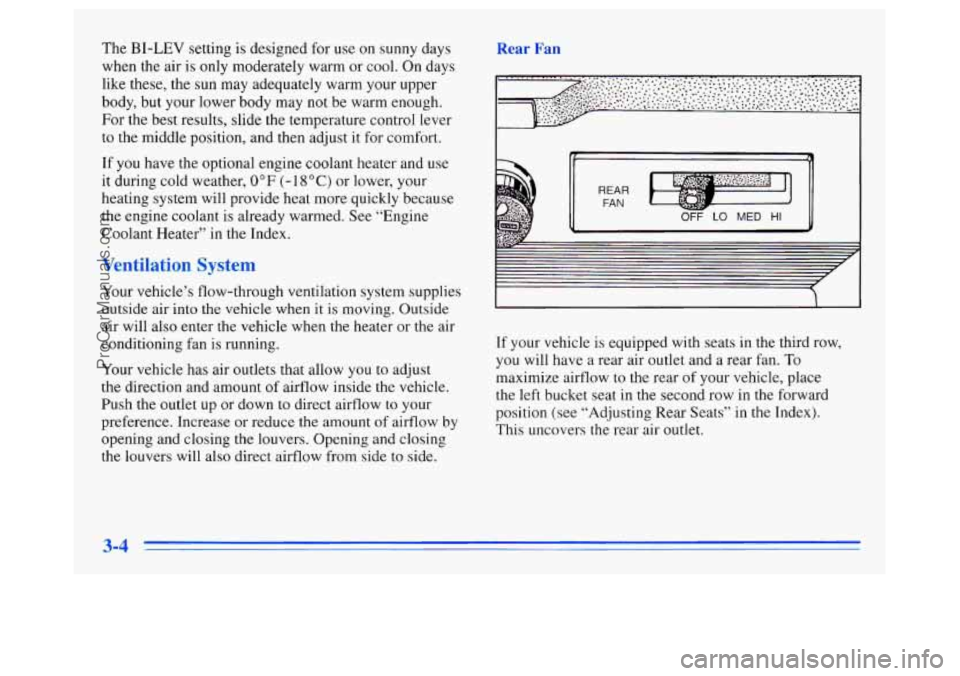
The BI-LEV setting is designed for use on sunny days
when the air is
only moderately warm or cool. On days
like these, the sun may adequately warm your upper
body, but your lower body may not be warm enough.
For the best results, slide the temperature control lever
to the middle position, and then adjust it for comfort.
If you have the optional engine coolant heater and use
it during cold weather,
0┬░F (-18┬░C) or lower, your
heating system will provide heat more quickly because
the engine coolant is already warmed. See ŌĆ£Engine
Coolant HeaterŌĆÖŌĆÖ
in the Index.
%til-.tion Syst
Your vehicleŌĆÖs flow-through ventilation system supplies
outside air
into the vehicle when it is moving. Outside
air will also enter the vehicle when the heater or the air
conditioning fan is running.
Your vehicle has air outlets that allow you to adjust
the direction and amount
of airflow inside the vehicle.
Push the outlet up or down to direct airflow to your
preference. Increase or reduce the amount
of airflow by
opening and closing the louvers. Opening and closing
the louvers will also direct airflow from side to side.
If your vehicle is equipped with seats in the third row,
you will have a rear air outlet and a rear fan.
To
maximize airflow to the rear of your vehicle, place
the
left bucket seat in the second row in the forward
position (see ŌĆ£Adjusting Rear SeatsŌĆØ in
the Index).
This uncovers the rear air outlet.
ProCarManuals.com
Page 208 of 372

Driving with a Trailer
A -CAUTION:
I
If you have a rear-most window open and you
pull
a trailer with your vehicle, carbon monoxide
(CO) could come into your vehicle. You canŌĆÖt see
or smell CO. It can cause unconsciousness or
death. (See ŌĆ£Engine ExhaustŌĆØ in the Index.)
To
maximize your safety when towing a trailer:
Have your exhaust system inspected for
leaks, and make necessary repairs before
starting
on your trip.
0 Keep the rear-most windows closed.
0 If exhaust does come into your vehicle
through a window in the rear or another
opening, drive with your front, main
heating or cooling system on and with the
fan on any speed. This will bring fresh,
outside air into your vehicle.
Do not use
RECIRC because it only recirculates the
air inside your vehicle. (See ŌĆ£Comfort
ControlsŌĆØ in the Index.)
Towing a trailer requires a certain amount of experience.
Before setting out for the open road, youŌĆÖll want to get
to know your rig. Acquaint yourself with the feel of
handling and braking with the added weight
of the
trailer. And always keep in mind that the vehicle you are
driving
is now a good deal longer and not nearly as
responsive as your vehicle is by itself.
Before
you start, check the trailer hitch and platform
(and attachments), safety chains, electrical connector,
lamps, tires and mirror adjustment.
If the trailer has
electric brakes, start your vehicle and trailer moving and
then apply the trailer brake controller by hand to be sure
the brakes are working. This lets you check your
electrical connection
at the same time.
During your trip, check occasionally to be sure that the
load is secure, and that the lamps and any trailer brakes
are still working.
Following Distance
Stay at least twice as far behind the vehicle ahead as you
would when driving your vehicle without
a trailer. This
can help you avoid situations that require heavy braking
and sudden turns.
ProCarManuals.com
Page 210 of 372
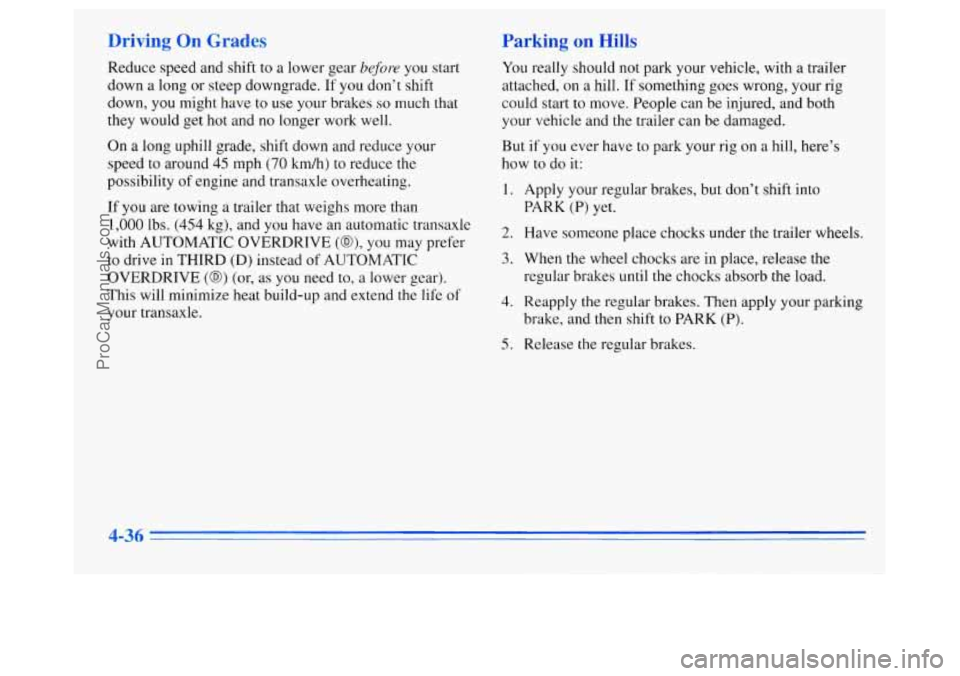
Driving On Grades Parking on Hills
Reduce speed and shift to a lower gear before you start
down a long or steep downgrade. If you donŌĆÖt shift
down, you might have
to use your brakes so much that
they would get hot and no longer work well.
On
a long uphill grade, shift down and reduce your
speed to around 45 mph
(70 km/h) to reduce the
possibility of engine and transaxle overheating.
If you are towing a trailer that weighs more than
1,000 lbs. (454 kg), and you have an automatic transaxle
with AUTOMATIC OVERDRIVE
(@), you may prefer
to drive in THIRD (D) instead of AUTOMATIC
OVERDRIVE
(@) (or, as you need to, a lower gear).
This will minimize heat build-up and extend the life
of
your transaxle.
You really should not park your vehicle, with a trailer
attached,
on a hill. If something goes wrong, your rig
could start to move. People can be injured, and both
your vehicle and the trailer can be damaged.
But
if you ever have to park your rig on a hill, hereŌĆÖs
how to do
it:
1. Apply your regular brakes, but donŌĆÖt shift into
PARK (P) yet.
2. Have someone place chocks under the trailer wheels.
3. When the wheel chocks are in place, release the
regular brakes until the chocks absorb the load.
4. Reapply the regular brakes. Then apply your parking
brake, and then shift to PARK
(P).
5. Release the regular brakes.
4-36
ProCarManuals.com
Page 224 of 372
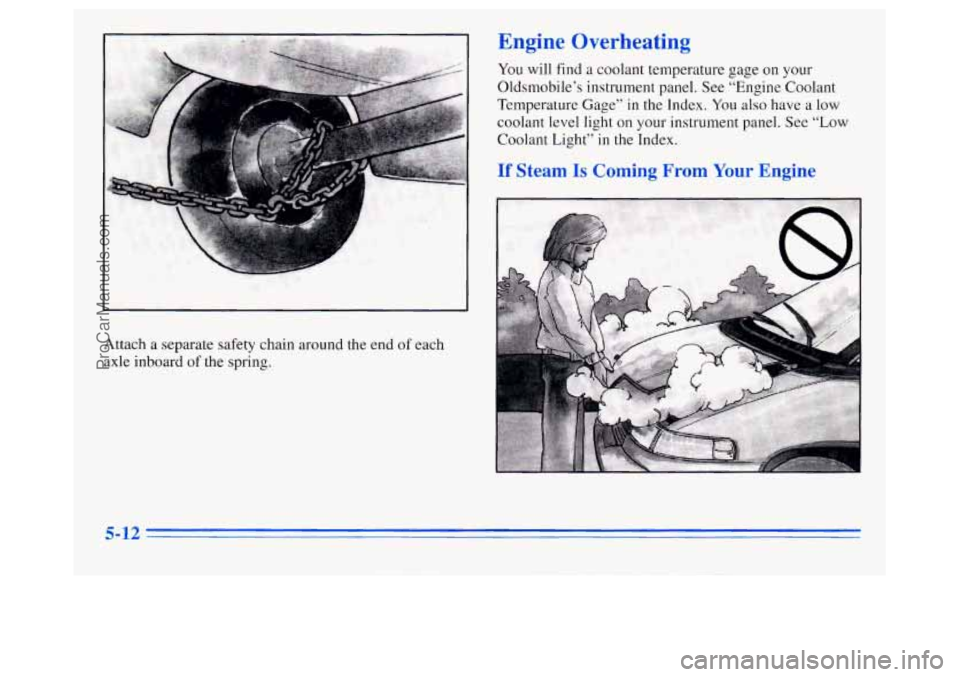
Attach a separate safety chain around the end of each
axle inboard
of the spring.
Engir Overheating
You will find a coolant temperature gage on your
OldsmobileŌĆÖs instrument panel. See ŌĆ£Engine Coolant
Temperature GageŌĆØ
in the Index. You also have a low
coolant level light on your instrument panel. See ŌĆ£Low
Coolant LightŌĆØ in the Index.
Steam Is COI d r From Your ine
I
5-12
ProCarManuals.com
Page 228 of 372

A CAUTION:
Heater and radiator hoses, and other engine
do, you can be burned.
DonŌĆÖt run the engine if there
is a leak. If you run
the engine, it could lose all coolant. That could
cause an engine fire, and you could be burned.
Get any leak fixed before you drive the vehicle.
1 parts, can be very hot. DonŌĆÖt touch them. If you
~
NOTICE:
Engine damage from running your engine
without coolant isnŌĆÖt covered by your warranty.
If there seems to be no leak, with the engine on, check to
see
if the electric engine fan(s) are running. If the engine
is overheating, both fan(s) should be running.
If they
arenŌĆÖt, your vehicle needs service.
How to Add Coolant to the Coolant
Recovery
Tank
If you havenŌĆÖt found a problem yet, but the coolant
level isnŌĆÖt
at or above the FULL HOT mark, add a 501.50
mixture of den72 water (preferably distilled) and
DEX-COOL TM (orange-colored, silicate-free) antifreeze
at the coolant recovery tank. (See ŌĆ£Engine CoolantŌĆØ in
the Index for more information.)
Adding only plain water to your cooling system
can be dangerous. Plain water, or some other
liquid like alcohol, can boil before the proper
coolant
mix will. Your vehicleŌĆÖs coolant warning
system is set for the proper coolant mix. With
plain water or the wrong mix, your engine could
get too hot but you wouldnŌĆÖt get the overheat
warning. Your engine could catch fire and you or
others could be burned. Use a
50/50 mix of clean
water and
DEX-COOL TM antifreeze.
5-16
ProCarManuals.com
Page 264 of 372

DW to 2 dl uid
Refer to the Maintenance Schedule to determine what
kind
of transaxle fluid to use. See ŌĆ£Recommended
Fluids and LubricantsŌĆØ in the Index.
If the fluid level is low, add only enough
of the proper
fluid to bring the level into the cross-hatched area on
the dipstick.
1. Pull out the dipstick.
2. Using a long-neck funnel, add enough fluid at the
dipstick hole to bring it
to the proper level. It doesnŌĆÖt
take much fluid, generally less than a pint
(0.5 L).
Don ŌĆÖt overfill. We recommend you use only fluid
labeled DEXRON@-111, because fluid with that
label is made especially for your automatic transaxle.
Damage caused
by fluid other than DEXRON-111 is
not covered by your new vehicle warranty.
0 After adding fluid, recheck the fluid level as
described under ŌĆ£How
to Check.ŌĆØ
When the correct fluid level is obtained, push the
dipstick back in all the way. The
cooling system in your vehicle is filled with new
DEX-COOL
TM (orange-colored, silicate-free) engine
coolant. This coolant is designed to remain in your
vehicle for
5 years or 100,000 miles (166 000 km),
whichever occurs first.
The following explains your cooling system and how to
add coolant when it is low.
If you have a problem with
engine overheating, see ŌĆ£Engine OverheatingŌĆØ in
the Index.
A 50/50 mixture of water and the proper coolant for
your Oldsmobile will:
0 Give freezing protection down to -34┬░F (-37┬░C).
0 Give boiling protection up to 265┬░F (129┬░C).
Protect against rust and corrosion.
0 Help keep the proper engine temperature.
0 Let the warning lights and gages work as they should.
ProCarManuals.com